If your plot involves any sort of violent crime, whether you’re a mystery/crime writer or not, you should know forensic nursing. In broad terms, forensic nursing is where the healthcare system and the legal system intersect.
 Photo credit: KOMUnews via Visual Hunt / CC BY
Photo credit: KOMUnews via Visual Hunt / CC BY
Survivors of violent crimes typically come through the ER, where their medical needs are taken care of—setting broken bones, stitching wounds, etc. Ideally, the patient spends as little time as possible in the controlled chaos and tension of the ER; the goal is no more than 45 minutes.
Then they are escorted to a quiet, comfortable room furnished much like a small living room, but with drinks and snacks as well as TV. Anyone accompanying the patient would typically wait here during the examination. The area is secured, and only people the patient chooses to bring are allowed into the room. These people might be family or, perhaps, a trained volunteer from an organization such as Hanover Safe Place, which supports survivors through what is inevitably a traumatic time at the hospital.
The patient then meets with a forensic nurse. The forensic nurse’s role is to record the details of the crime and collect physical evidence. This process typically takes 3 to 4 hours.
Background information comes first, including general medical history as well as questions about any injuries, surgeries, diagnostic procedures, or medical treatments that might affect the physical finding. But then come pages of more detailed and focused questions. For example, in cases of sexual assault, not only question about the assault itself and perpetrator(s) but also about the date, time, type, partner’s race, and relationship of last consensual intercourse; and since the assault, whether the patient bathed or showered, douched, brushed teeth, defecated, urinated, vomited, wiped or washed affected area, changed clothes, or had consensual intercourse.
For strangulation cases, they ask how the patient was strangled—one-handed, two-handed, knee, forearm, ligature—how long it lasted, and whether there was more than one incident.
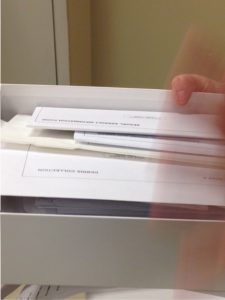
A danger assessment is conducted as well, focusing on whether the violence is escalating in severity or frequency, whether weapons (especially guns) are available and/or used, drug or alcohol use, presence of children, and control of the survivor’s daily activities and social interactions.
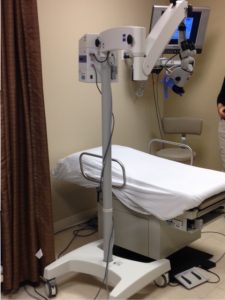
Although the verbal data are crucial, the physical exam is central to forensic nursing. Samples of blood, urine, hair, and swabs of orifices are taken. Specialized equipment is available. Photographs are taken. Hair is combed, nails cleaned and clipped. The patient stands on a plastic sheet to remove clothing, to catch any random debris.
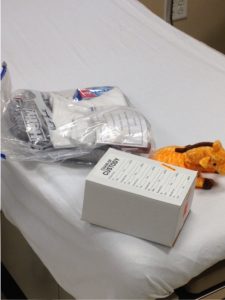
Chain of custody must be carefully controlled and documented.
Children have special treatment as well. They are given a toy that they can keep. They’re also given tablets and pencils or markers to draw pictures that can help in understanding the assault. Sometimes an outline of a person is presented for the child to mark where he or she was touched or hurt.
Improvements and refinements are always in progress. Once upon a time, a survivor might be asked to detail the crime by a dozen different people. Now recounting the crime waits for the forensic nurse, diminishing the impact of reliving it.
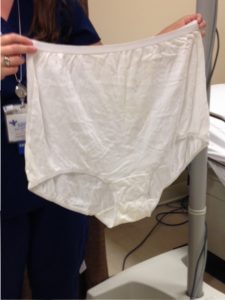
When a patient’s clothes are taken in evidence, they are given generic going-home clothes. These are grey sweatpants, t-shirt, and—until recently—the granny panties pictured above, one size for all. A college student survivor said that having to wear those granny panties made her feel violated all over again.
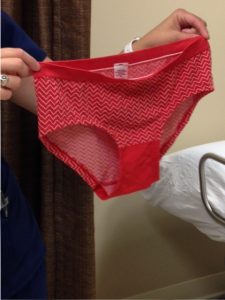
She organized her sorority sisters to provide hundreds of pairs of new panties in varied colors, styles, and sizes. All of the clothing provided to survivors is donated. Should you or your group want to donate new clothes, new toys, child pillowcases, gas cards, food cards—or money!—here’s your contact. And, by the way, she gives talks about the program.

Forensic nursing is a relatively new medical specialty. In 1992, 72 registered nurses—mostly sexual assault nurse examiners—came together to form the International Association of Forensic Nurses. Since 1993, Bon Secours Forensic Nursing in Richmond has served survivors of sexual assault, child sexual abuse, and domestic violence. Now a team of 10 full-time nurses work with 26 agencies to serve survivors of any type of violent crime.
Bon Secours is atypical. There are over 300 hospitals in Virginia, and many of them have no full-time forensic nurses. Therefore, patients from all over central Virginia can end up at Bon Secours. They assist more than 2,200 patients per year.
Bon Secours is a premier forensic nursing program. For the sake of your story line, you might create more conflict in the story if the characters botch the process. A screw-up could taint evidence or miss it. Insensitive treatment could leave the survivor among the walking wounded.
Last but not least, put this worthwhile event on your calendar!

Benefiting Bon Secours Forensic Nursing
Sunday, October 30, 2016
2:00-5:30 p.m. at Hilton Richmond
Hotel & Spa
Short Pump
Yes, there are offbeat animal detectives. In Three Bags Full: a sheep detective story by Leonie Swann, the shepherd is murdered and the sheep, led by the ewe Miss Marple, set out to discover the murderer. In Anonymous Rex, by Eric Garcia, dinosaurs continue to live among us, disguised in latex masks and tail girdles. Otherwise, Rubio is the classic hard-boiled detective. Freddy the Detective by Walter R. Brooks features a pig detective. Bernd Heinrich writes ravens, by far the smartest of birds. And Elmore Leonard, in his first children’s novel, created Antwan, a hip-talking coyote living in the Hollywood Hills, for A Coyote’s in the House.
Dogs are poorly represented in the mystery genre. In Hank the Cowdog, Hank is the inept “Head of Security” for a ranch, and setting out to find who’s stealing the corn, he sets clever traps that consistently trap him. Play Dead by Leslie O’Kane features a dog behaviorist/therapist and an “ugly collie” rescue dog.
Cats, on the other hand, are everywhere. There are whole series featuring cats. Think the Mrs. Murphy series by Rita Mae Brown and Sneaky Pie Brown, or The Cat Who… series by Lilian Jackson Braun. Perhaps less well known is the Joe Grey Cat Mystery series by Shirley Rousseau Murphy, in which Joe is a cat from the Catswold that can speak and understand English, among other talents. And then there is the series in which the point of view shifts between a big black cat named Midnight Louie and his person, Temple Barr.
Why cats? Well, for one thing, they are notoriously independent and sneaky. They were domesticated tens of thousands of years after dogs—or maybe not yet, even. Cats are confounding creatures, for centuries associated with death cults, witches, Satan, black magic, and so forth. So creating fictional cats with paranormal abilities—talking, shape shifting, psychic reasoning or implausible acts of physical derring-do, invisibility, tele-transportation—is much less jarring than similar traits in a dog—or sheep, goat, pig. A monkey, now . . .
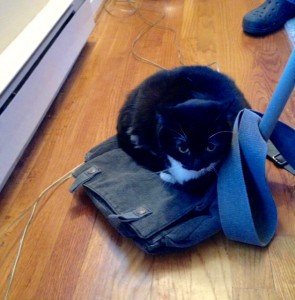
So, if you want to sample some cat detective fiction, apart from what’s mentioned above, consider the following: A Cat Tells Two Tales and/or The Cat, The Vagabond, and The Victim by Lydia Adamson; The Cat, The Mill, and The Murder by Leann Sweeney; All Dressed Up and No Place to Haunt by Rose Pressey; Cat In a White Tie and Tails by Carole Nelson Douglas; Tailing a Tabby by Laurie Cass; Cat Nap and/or Last Licks by Claire Donally; No Cooperation From The Cat by Marian Babson; Literally Murder by Ali Brandon;The Cat, The Devil, The Last Escape by Shirley R. & Pat J. J Murphy. And I’m sure there are others out there.
By the way, as far as I know, cat detective stories are all written by women and feature women partners for the cats. Surely there are deep historical associations between women and cats.
If you are thinking about adding an animal detective to your mystery, consider the competition—and riding the wave of popularity!
I have a story in the upcoming collection Virginia is for More Mysteries (Koehler Books, April 2016) titled “War and Murder at Nimrod Hall.” This is a sequel to “Death Comes to Hollywood Cemetery,” which appears in Virginia Is For Mysteries. It follows Clara as she escapes war-torn Richmond in 1862 only to encounter wounded soldiers and spies in Bath County.

You can find Virginia is for Mysteries on IndieBound, Amazon, Kobo, and Barnes and Noble.